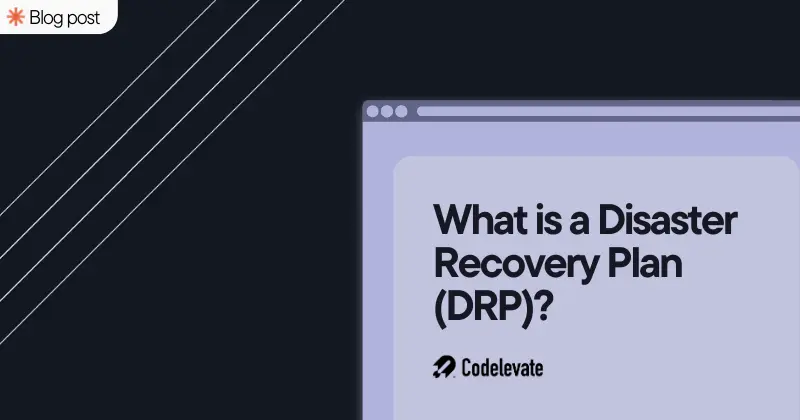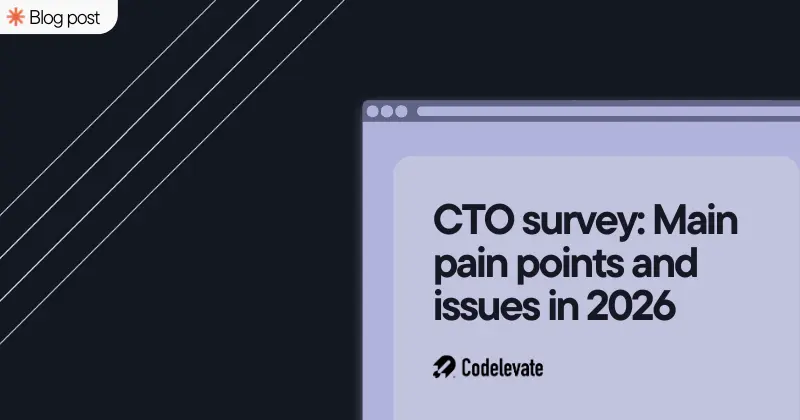Tailwind CSS vs Material UI - A comprehensive guide 2024
Greetings, developers and digital architects! As we navigate the dynamic landscape of web development, the choice of a CSS framework takes center stage in shaping the online experiences of tomorrow. Enter the era: Tailwind CSS and Material UI, each coming with its unique prowess in the art of digital styling.
At Codelevate, we embark on a purposeful exploration, peeling back the layers of both Tailwind CSS and Material UI to illuminate the distinctive features that define these frameworks. In this journey of discovery, our goal is to equip you with the insights necessary to make informed decisions, ensuring your projects are not just functional but stand as paragons of digital innovation.
In the ever-evolving era of 2024, where every pixel matters, your choices bear significance. Join us as we unravel the technical intricacies, offering you a compass in the labyrinth of web design. In this article, you are going to learn about Tailwind CSS, Material UI and which one to use for your next project.
What is Tailwind CSS?
Tailwind CSS is like the Swiss Army knife for developers. It's famous for its utility-first approach, making it a breeze for developers to whip up custom designs. It comes pre-loaded with classes that handle responsive design, making mobile-first development a walk in the park. The best part? It's super flexible. Tailwind lets you tweak and customize to your heart's content, keeping your website speedy with minimal CSS. Plus, it's got a bustling community, plays well with other frameworks, and is a pro at theme integration.
But, fair warning for newbies – there's a bit of a learning curve, and sometimes your HTML can look like a wordy novel with all those class names. It's like speaking Tailwind's secret language, but once you get the hang of it, you're in for a smooth ride.
Advantages of Tailwind CSS:
Utility-First Approach:
In a nutshell: Tailwind speaks the language of efficiency. Developers can craft unique designs with ease by using small, purpose-driven utility classes directly in the HTML. This smart approach means you're not drowning in custom CSS, making development a smooth sail.
Responsive Design:
Simply put: Tailwind is ready for any screen size or device. With built-in classes for responsive design, it's your go-to for creating websites that look good whether you're browsing on a giant desktop or a tiny smartphone. Your web apps will be like the superhero of adaptability.
Customization:
Tailwind is your personal design playground. Developers have the power to customize everything to fit their projects perfectly. Whether it's tweaking configurations or creating custom themes, Tailwind ensures your web creation is as unique as a fingerprint.
Performance:
Tailwind is the speedster of CSS frameworks. It generates just the right amount of CSS, making your web apps load faster. Less unnecessary styles mean a smoother and more efficient user experience for your visitors.
Community and Ecosystem:
Join the Tailwind party! With a vibrant community and a bustling ecosystem full of plugins and extensions, Tailwind is more than just a framework – it's a community-driven movement. You're not just building websites; you're part of something bigger.
Integration with Other Frameworks:
Tailwind plays well with everyone. It's not exclusive to any specific frameworks – easily integrating with various front-end libraries and frameworks. This adaptability makes Tailwind the social butterfly of CSS frameworks, perfect for developers using different tech tools.
Easy Theming Integration:
Theming with Tailwind is like a walk in the park. Developers can seamlessly integrate themes into their projects without breaking a sweat. It's like giving your web app a fresh coat of paint – easy, consistent, and visually appealing.
Disadvantages of Tailwind CSS:
Steep Learning Curve:
In simple terms: Tailwind is a bit like learning a new dance. For beginners, the powerful utility-first approach might feel like stepping into a complex routine. It's not impossible, but it takes time to groove with the extensive set of utility classes and their combinations.
Verbose Class Names:
Picture this: Your HTML files are like a party, but as the guest list grows, things get crowded. With Tailwind, the class names can be a bit chatty, making your code look like a lively conversation. It's not a problem per se, but managing and navigating through these wordy class names might need a little extra effort.
Few Pre-styled Components:
Think of Tailwind like a minimalist wardrobe. It doesn't come packed with an endless array of pre-styled components like some other CSS frameworks. So, developers might find themselves in a DIY fashion show, creating more styles from scratch. It's like Tailwind is nudging you to be the fashion designer of your web elements, which is cool but requires a bit more hands-on work.
.jpg)
Material UI
Welcome to the world of Material UI, where design meets functionality in a seamless dance. Crafted with precision, Material UI is a CSS framework that embodies the principles of Material Design, offering a playground of pre-designed components and a canvas for customization. As we unravel the intricacies of Material UI, let's explore the advantages and disadvantages that shape its identity in the web development arena.
What is Material UI?
Material UI is a cutting-edge CSS framework that blends design aesthetics with functionality, offering developers a powerful toolkit for crafting visually stunning and user-friendly web applications. Rooted in the principles of Material Design, a design language developed by Google, Material UI provides a cohesive set of pre-designed components that adhere to a common visual language.
At its core, Material UI empowers developers to create interfaces that are not only aesthetically pleasing but also intuitive and consistent. The framework's extensive library of pre-styled components simplifies the development process, enabling developers to assemble responsive and polished interfaces with minimal effort.
Designed with React integration in mind, Material UI seamlessly incorporates into React-based projects, streamlining the development workflow for those immersed in the React ecosystem. The framework's commitment to a consistent user interface, active community support, and continuous updates further solidify its position as a robust solution for building modern and visually appealing web applications.
Advantages of Material UI:
Pre-designed Components:
Think of Material UI as a treasure trove of pre-designed wonders. With a rich collection adhering to Material Design guidelines, this framework provides ready-to-use components that simplify and elevate the development process. It's like having a toolkit full of elements that bring consistency and style to your projects.
Customization:
Material UI isn't just about ready-made designs; it's about making them your own. Developers wield the power of theming, customizing the look and feel of components to align seamlessly with the branding and design nuances of their projects. It's design freedom at your fingertips.
Consistent Design:
Material UI is the maestro orchestrating harmony in user interfaces. By strictly adhering to Material Design principles, this framework ensures a consistent visual experience across applications. It's the secret sauce for creating interfaces that not only look good but feel familiar and intuitive.
Community Support:
Joining the Material UI journey means being part of a robust community. With active contributors and a wealth of community-driven resources, Material UI thrives on collective expertise. Regular updates enhance stability, and shared knowledge propels the framework forward.
Integration with React:
Designed with React in mind, Material UI is the perfect dance partner for React-based applications. Its seamless integration simplifies the development workflow, ensuring a smooth and efficient coding experience for React enthusiasts.
Disadvantages of Material UI:
Size:
Every treasure comes with a weight. Material UI's extensive library of pre-designed components can contribute to a significant bundle size. This might add a bit of weight to your project, impacting overall load times.
Overhead in Customization:
While the canvas is vast, painting specific strokes may require extra effort. Customizing intricate design modifications in Material UI may involve overriding default styles, leading to a potentially complex and time-consuming process.
Limited to Material Design:
Material UI has its design compass pointing firmly at Material Design principles. While this consistency is a strength, it can be a limitation for projects that yearn for a different design language. Customizing beyond Material Design might be a challenge.
Learning Curve:
Stepping into the Material UI world means mastering the duo: React and Material Design principles. For those unfamiliar with these technologies, there might be a steeper learning curve on the path to mastery.
Potentially Overpowering:
Material UI's abundance of pre-built components is a boon, but relying too heavily on them might overshadow creativity. Overusing these elements could lead to a less unique or personalized user interface.
Hard to Change Themes:
Changing themes in Material UI isn't a light switch. The framework's intricate styling system might make it a bit challenging, especially for projects that demand frequent theme changes or dynamic theming approaches.
Which should you choose?
In the grand spectrum of web development, the choice between Tailwind CSS and Material UI depends on your project's unique needs. Tailwind CSS embraces utility-first development, offering flexibility, while Material UI excels in providing a cohesive design system. Consider factors like project scale, team expertise, and design preferences to make the right call.
Conclusion:
Codelevate stands at the crossroads of innovation and excellence, acknowledging the pivotal role of selecting the right CSS framework. Whether you lean towards Tailwind CSS's flexibility or Material UI's comprehensive design system, we can help you in the journey of web development. Dive into our Figma Tailwind CSS design system or connect with us directly for projects leveraging Material UI or Tailwind CSS.





.svg)




